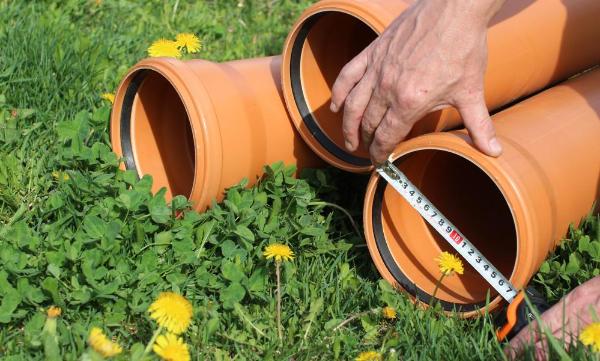How to montage clamps
 1. Polypropylene piping systems must not be installed at ambient temperatures below -10°C.
1. Polypropylene piping systems must not be installed at ambient temperatures below -10°C.2. Installation of risers should be carried out from the bottom up; pipes, pipes and fittings (except for two-pipe pipes and couplings) on the vertical and horizontal sections of the pipeline system should be directed towards the flow of sewage.
3. Horizontal pipelines should be laid with a design bias; deviation of sewer risers from the vertical axis more than 2 mm on 1 m of the mounted pipes is not allowed.
4. Cutting and shortening of shaped parts is prohibited.
5. Fixed fastening of pipelines with a diameter of 40-110 mm is allowed to carry out by dense compression of a pipe by a clamp.
6. As mobile mounts should be used the clamps, the internal diameter of which is 1-2 mm larger than the outer diameter of the mounted pipe.
7. During installation of piping systems internal drainage, allowing the transportation of regular waste water temperature 80°C, prohibits the replacement of parts of articles to less heat-resistant parts made of polyvinyl chloride (PVC) or polyethylene (PE) intended for the permanent diversion of wastewater with a temperature of 60°C.
8. It is necessary to use sleeves from a rigid material (a pipe, steel, etc.) for pass of plastic pipes through walls. The size of the liner should exceed in length the thickness of bulkhead 20-30 mm, and the diameter of the sleeve should be larger than the diameter of tubing 15-20 mm.
9. Laying of internal Sewerage networks should be provided:
- open – in the underground, basements, with mounting to the structures of buildings;
- hidden – with sealing in the construction of floors.
Laying of the Sewerage from plastic pipes in the earth, under a building floor, taking into account possible loadings is allowed. In multi-storey buildings for various purposes, when using plastic pipes for internal sewage systems and drains, the following conditions must be observed:
a) laying of sewer pipes and drainpipes to conduct it is hidden;
b) in basements of buildings in the absence of their production warehouse and office space, as well as in attics and bathrooms of residential buildings, the construction of sewage and drainage plastic pipe can be open;
C) places of pass of struts through overlappings shall be closed up with cement mortar on all thickness of overlapping;
d) the site of a strut above overlapping on 8-10 sm (to the horizontal branch pipeline) should be protected with a cement mortal in the thickness of 2-3 sm;
e) before sealing of a strut with a solution of a pipe it is necessary to wrap a rolled waterproofing material without a gap.
10. In front of the audits on the risers when laying concealed should be provided with manholes not less than 30 × 40 cm (SNiP 2.04.01-85*).
11. While laying sewer pipes in communication mines strobach, channels and conduits enclosing structure providing access into the shaft, box, etc., must be performed in accordance with SNiP 2.04.01.
12. Pipelines shall not adjoin closely to a surface of building designs. The distance in light between pipes and building structures should be at least 20 mm. (SP 40-102-2000)